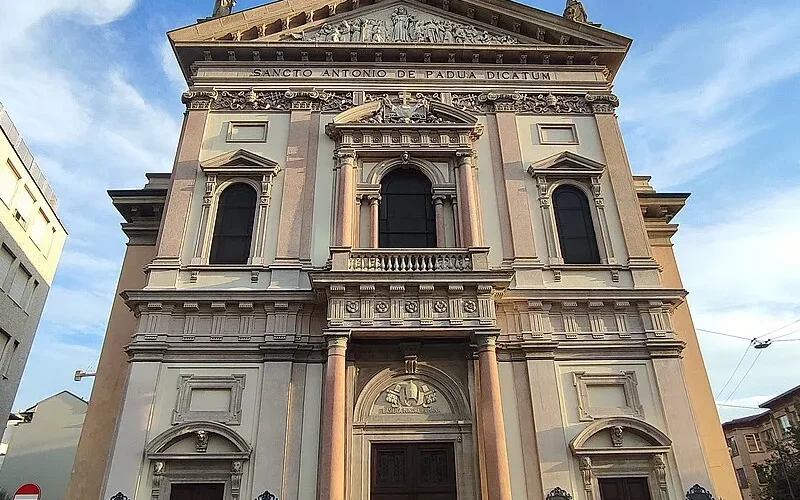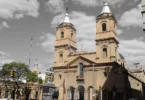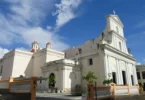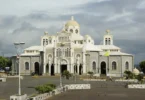Introduction

The Sanctuary of Saint Anthony of Padua is a prominent church in Milan, Italy, entrusted to the Order of Friars Minor, a branch of the Franciscan order. Located on Via Carlo Farini, the sanctuary is positioned in close proximity to notable landmarks such as the Monumental Cemetery and the Porta Garibaldi Railway Station. This church holds significant importance as a place of worship and pilgrimage, dedicated to Saint Anthony of Padua, one of the most beloved saints of the Catholic Church. The sanctuary attracts visitors for both its spiritual value and its historical connection to the Franciscan community. Its location also makes it easily accessible for those traveling around the Milan area.

The history of the Sanctuary of Saint Anthony of Padua in Milan dates back to 1872, when the Hospice of the Holy Land was established just outside Porta Tenaglia. Managed by the Friars Minor, the hospice included an adjoining convent and a chapel dedicated to the Immaculate Conception, which was built between 1875 and 1876. Over time, the convent expanded, and by 1898, it became the seat of the curia for the newly established province of the Friars Minor. This role continued until 1954.
As the Friars Minor’s presence in the area grew, the decision was made to build a new, larger church. The project for the new church, dedicated to Saint Anthony of Padua, was entrusted to the Milanese architect Paolo Cesa Bianchi. Construction of the church took four years, and it was completed in 1902. The church was solemnly consecrated by Cardinal Andrea Ferrari, Archbishop of Milan, on 12 June 1902, just before the feast day of Saint Anthony of Padua.
Between 1932 and 1937, the church underwent further expansion. The addition of new naves, side chapels, and a bell tower, designed by Ugo Zanchetta, significantly altered the structure. On 18 July 1937, the sanctuary was elevated to the status of a minor basilica by Pope Pius XI. Additionally, the church was officially designated as a parish church on 5 February 1957 by Giovanni Battista Montini, the Archbishop of Milan, who would later become Pope Paul VI.
In 1971, significant changes were made to the presbytery area with the installation of a new high altar and pulpit, both designed by renowned architect Giovanni Muzio. Muzio had also designed the new oratory annexed to the convent in 1965. The church underwent a series of restorative works between 1995 and 2001, during which both the interior and exterior were carefully restored to preserve the sanctuary’s beauty and historical significance.
Architecture of Sanctuary of Saint Anthony of Padua in Milan, Italy

External Description
The Church of Sant’Antonio di Padova is located at the intersection of Via Pietro Maroncelli and Via Carlo Farini, framed by a small triangular plaza. At the center of this open space is a tree-lined flowerbed with a fountain, featuring a bronze statue of Saint Anthony of Padua preaching to the fish. This statue, created by sculptor Giuseppe Maretto, was unveiled in 1932 to commemorate the seventh centenary of St. Anthony’s death. The base of the statue is inscribed with the sculptor’s name and the year: “Giuseppe Maretto 1932 X.”
The church’s façade is designed in a neo-Baroque style, drawing inspiration from 18th and 19th-century Milanese architecture. It is divided into two levels, separated by a high cornice adorned with metopes and triglyphs. The lower section has three portals, with wooden doors. The two side portals are topped with semicircular tympana, while the central portal is crowned with a lunette, featuring a bas-relief of a tiara and keys, and the inscription “Roman Minor Basilica.” The portals are preceded by a small, protruding porch supported by two Tuscan columns made of red marble and topped with a balustrade. Above, the upper level features three lancet windows with rounded arches, the central one set within an Ionic serliana. The façade concludes with a pediment carved with a bas-relief image of Saint Anthony of Padua holding the Child.
On the church’s left side rises a 55-meter-high bell tower, topped by a 5-meter statue of Saint Anthony holding the Baby Jesus. The bell tower is designed in an Art Nouveau style, with walls composed of alternating red brick and light plaster. It bears the coat of arms of the Friars Minor Order. The tower’s base is square, while the tower itself has a circular plan. It houses five bells in C3 major. At the very top, a cast-iron statue of Saint Anthony with the Child completes the structure.
Interior Description

The interior of the Church of Sant’Antonio di Padova is characterized by an eclectic style, blending neoclassical, neo-Renaissance, and neo-Baroque elements.
The church has a three-nave layout, with a single deep semicircular apse and no transept. The central nave is covered with a flat ceiling, painted with scenes from the life of Saint Anthony by Attilio Andreoli. This nave is divided into eight bays by beams supported by semi-columns and is separated from the side naves by round arches resting on pillars. Above the naves, a matroneum overlooks the central nave, featuring mullioned windows with composite columns. Between the fifth and sixth bays of the central nave, on the left side, there is a carved wooden pulpit.
Each of the two side naves has three chapels, located at the fifth, sixth, and seventh bays. The chapels on the right are dedicated to Saint Joseph, Saint Francis of Assisi, and the Sacred Heart of Jesus, while those on the left are dedicated to Jesus Crucified, Saint Clare of Assisi, and the Madonna. At the foot of the altar in the chapel dedicated to Saint Anthony rest the venerated remains of the bishops of Mogadishu: Bernardino Bigi, Fulgenzio Lazzati, and Salvatore Colombo, a martyr of charity who was killed in Somalia on July 9, 1989.
The central nave culminates in the apse, which is preceded by an arch with a vaulted ceiling supported by two loggias with round arches. These arches are decorated with statues of eight Franciscan saints and are supported by Tuscan columns. Below this is the presbytery, which is raised by a few steps. At its center, behind the modern high altar (designed by Giovanni Muzio in 1971), is a neoclassical marble aedicule that houses a polychrome statue of Saint Anthony of Padua with the Baby Jesus.
The semicircular apse contains the wooden stalls of the friars’ choir, and above them is the pipe organ. The apse’s basin is frescoed with the Glory of Saint Anthony.
Pipe Organ

Behind the main altar, within a niche in the back wall of the apse, is the Mascioni opus 718 pipe organ, which was built in 1955. This electrically operated instrument features a total of 36 registers. The sound chamber is positioned overlooking the apse, with four square niches: three on the left showcase the main pipes, arranged in a single spire with lateral wings, while the right niche is unadorned and closed off with a polychrome glass window. The independent console is located centrally in the friars’ choir within the apse. It is simply designed, with no elaborate decorations, and contains three keyboards of 61 notes each, along with a concave-radial pedalboard with 32 notes.
Feast Day
Feast Day : 13th June
The feast day of Santuario di Sant’Antonio di Padova (Sanctuary of Saint Anthony of Padua) in Milan, like in many places honoring Saint Anthony, is celebrated on June 13th. This date commemorates the death of Saint Anthony of Padua, who passed away on June 13, 1231. The day is marked with special masses, prayers, and celebrations at the sanctuary.
Church Mass Timing
Monday : 7:00 AM , 8:15 AM , 6:30 PM
Tuesday : 7:00 AM , 8:15 AM , 6:30 PM
Wednesday : 7:00 AM , 8:15 AM , 6:30 PM
Thursday : 7:00 AM , 8:15 AM , 6:30 PM
Friday : 7:00 AM , 8:15 AM , 6:30 PM
Saturday : 7:00 AM , 8:15 AM , 6:30 PM
Sunday : 7:30 AM , 9:00 AM , 10:30 AM , 12:00 PM , 6:00 PM
Church Opening Time:
Monday : 6:30 am – 7:30 pm
Tuesday : 6:30 am – 7:30 pm
Wednesday : 6:30 am – 7:30 pm
Thursday : 6:30 am – 7:30 pm
Friday : 6:30 am – 7:30 pm
Saturday : 6:30 am – 7:30 pm
Sunday : 7:00 am – 7:30 pm
Contact Info
Address:
Via Carlo Farini, 10, 20154 Milano MI, Italy.
Phone : +39026551145
Accommodations
Connectivities
Airway
Milan Malpensa Airport (MXP) to Santuario di Sant’Antonio di Padova (Milano) distance between 40 min (44.6 km) via A8.
Railway
Milano Centrale to Santuario di Sant’Antonio di Padova (Milano) distance between 10 min (2.6 km) via Via Melchiorre Gioia.








